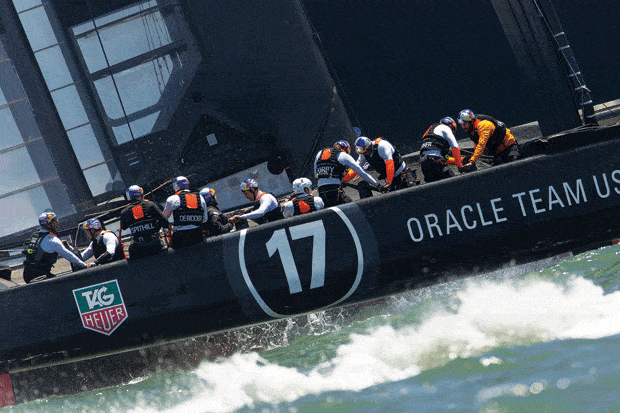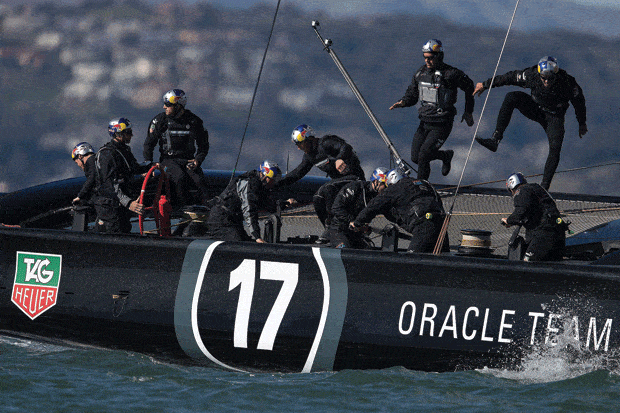
Oracle Team USA Division
Once the America’s Cup went multihull, it was widely thought that the grinders would be first to the unemployment line. Yet the situation today is very much the opposite as we enter the 34th America’s Cup. Of the 11 crewmembers onboard Oracle Team USA’s 17, eight are essentially full-time grinders. Long gone are the traditional divisions between foredeck teams, pitmen, and trimmers. Still, there’s a complex choreography to every maneuver on an AC72 because we’re effectively sailing two boats at once. Each crewmember has multiple jobs to do on one side and then must get to the other hull and right into those same jobs.
Improvements to boathandling have been dramatic over limited days of testing, and even as we developed our second boat, we were still figuring out the most efficient way to sail the boat and use the people and strength on board. There will not be nearly as many maneuvers as there were in past Cup races, but there will be a lot to gain with every single maneuver.
At Oracle Team USA we use a program that maps the platform and shows (with dots on the screen) how each crewmember moves across the boat during each maneuver. This tool has helped us reorganize some of our critical hardware and ensure we have the right people in the right cockpits. For example, the daggerboard controls—up, down, and pitch—were in Cockpit 2 on our first boat. We learned pretty quickly that we needed the board controls to be in Cockpit 3, closer to the helmsman, so we’d have a better line of communication. That’s the cool part of being involved with the first generation of this class: We’re all starting down this path together trying to find the best way of doing things.
Position by number
The unique thing with our boat is that we’re divided into four cockpits and are quite segregated, but we’re fairly homogeneous when it comes to the workload. The two guys in Cockpit 1 (the forward-most cockpit) pump the hydraulics, helping the guys in Cockpit 3 with raising and lowering the daggerboards. They can also link into the primary winch to help through tacks and jibes. The crewmember facing forward in Cockpit 1 [Position 2] is more or less the pitman; he loads the gennaker halyard for the hoist, triggers the halyard’s trip line, and manages the halyard through the gennaker drop. The crewmember facing aft in Cockpit 1 [Position 1] will burst to leeward to lay the furled gennaker on the trampoline as it’s coming down—and then get right back to his pedestal.
The guys in Cockpit 2 help the forward crew when hoisting the gennaker halyard. They also assist with grinding the primary winch for the tacks and jibes, and link into the mainsheet winch when we’re reaching or on the wind. They also manage the platform hydraulics, loading the gennaker forestay, the jib cunningham, powering the wing functions—twist and camber—and moving the jib car positions. They’ve got a busy role in Cockpit 2.
Cockpit 3 is primarily focused on managing the daggerboard—lowering, raising, and changing the board’s pitch. That cockpit team also powers the hydraulic cylinders that are controlling the boards and can be linked into the wing winch. They’re linking in and out between those two roles. They’re also linked in for the furl, the hoist, and the jibes.
Nestled between Cockpit 2 and 3 is the primary trimmer; he manages the jib or gennaker sheet. He doesn’t do a lot of grinding. He’s casting off, running to the other side, and taking the sheet handoff. Or, he’s handing it off before the castoff, running to leeward, and tailing the new sheet. In this scenario, the grinder facing forward in Cockpit 2 will do the castoff.

That brings us to Cockpit 4. Position 8 is the wing trimmer, who is managing the wing and the hydraulics that control it. During a tack or jibe, the wing trimmer will also get involved in grinding on the other side, if he gets across in time, handing off the wing winch to the tactician before he goes across. The wing trimmer is critical because we’re finding that as we go with smaller and smaller headsails, most of our power is coming from the wing.
Position 9 is the helmsman, Jimmy Spithill, and he’s obviously focused on driving and flying the boat. He has controls at the helm station that operate the pitch of the daggerboards, so he can control the flight and the ride height. That means flying the boat through maneuvers as well.
Position 10 is the strategist and offside helmsman. At the moment it’s Tom Slingsby. Going into a tack or jibe, Slingsby will take over control of the helm from Spithill and finish off the maneuver while Spithill is running across the boat. Once he’s back on the helm and controlling the flight, Slingsby can cross the boat and grind. The aft-most pedestal is primarily for wing trim. It is not connected to any hydraulic pumps. That pedestal can also link forward, allowing us to have all eight men into a furl, deploy, or gennaker hoist.
Position 11 is the tactician. We identified early on that everyone’s going to be on the pedestal at one point or another, so we all needed to get stronger, and John Kostecki hasn’t held back at all. He’s going to have a busy job on the racetrack because his physical input is as important as everyone else’s, and he will need to have his head out of the boat, figuring out where we should go. He’ll be busier than he ever was in the past. Even on the trimaran for the 33rd America’s Cup, the tactician had the luxury of looking around to make decisions. This time, everything will be happening very quickly.
We learned from the America’s Cup World Series that the start, the first leg, the first turning mark, and the first reach into the first jibe are key. If we get off the line well and get through that first jibe with clear air and a good line downwind, we’ll be in good shape. That’s what is so cool about the racetrack; there’s a premium on nailing it. In the old days, if you had superior boatspeed you could recover after a bad maneuver. This time, the boats will be fairly similar in speed, so we need to get our nose in front and spear off downwind straight away. We’ve spent a lot of time perfecting that first leg: getting on the foils, reaching fast, and then being able to do a controlled bear-away without coming off the foils. Then, there’s still the bottom of the racetrack. Getting the final layline right will be essential, as will furling and putting away the code zero. At the bottom mark there is the opportunity for huge gains and losses.
Full speed off the starting line
First, let’s break down the speed build approaching the starting line. Here, Positions 1 and 2 grind, assisting Cockpit 3 with the daggerboard height and supplying the hydraulic oil that allows the helmsman to control the pitch and fly the boat. Cockpit 2 pulls the jib in and then goes straight to powering the wing winch. Once the boat is foiling, Cockpit 3 also helps with the wing. The sooner Cockpits 2 and 3 get linked into the wing winch, the better. Once on the foils, the wing is the priority.
Exiting the first turning mark
For a straight bear-away, there’s little, if any, movement across the boat. Everyone stays in the same roles. The key is keeping the boat on the foils, level, and going fast. Because there’s such a short amount of time between the first mark and boundary, however, teams will be setting up for an early jibe. You’ll first see the trimmer and one of the grinders going to leeward to set up and take on the new sheet. Most of the guys will stay on the weather side to maintain stability and righting moment as long as possible. We try to minimize movements because the boat can destabilize quickly and fall off the foils. It’s like any other raceboat: You want to remain hiking for a long as possible before going into the maneuver.
Speeding through the flying jibe
All four cockpits link into furling the code zero. Once that’s done, the guys start to peel out and cross the boat. Cockpit 3 gets the new board down, and then guys in Cockpits 2 and 4 peel off to leeward to grind the new sheet. Once the boards are down, Cockpit 3 goes to the new weather side. Then the remaining guys in the two front cockpits cross. The choreography between the helmsmen coordinating the handoff, and the timing with Cockpit 3 to get the board down and the right pitch, is essential.
Fast and smooth at the bottom
Before the bottom mark we’ll have a full eight-man effort on the headsail furl. We get it off the lock at the top of the wing and snaked down onto the trampoline as quickly as possible. Then the guys settle into their upwind roles. After Cockpit 1 and 2 are done furling the gennaker, they assist Cockpit 3 with the boards. Once the boards are set, they grind in the wing to an upwind setting. We don’t have a huge amount of mainsheet to grind like we used to in the past, but the wing-trim sheet is just as loaded. The goal is to fly the boat into the bottom mark as efficiently as possible and have a nice smooth rounding.









